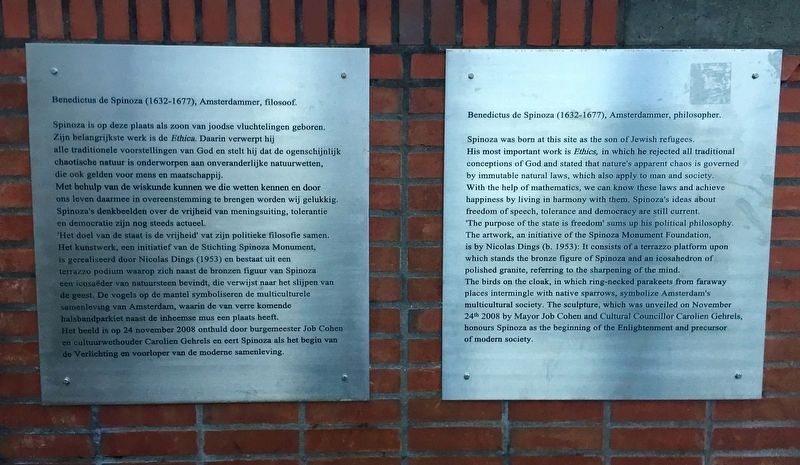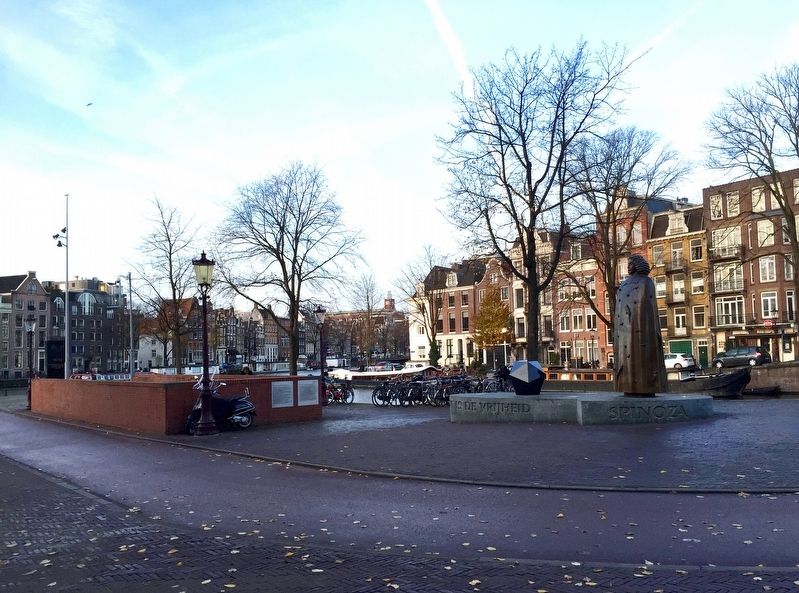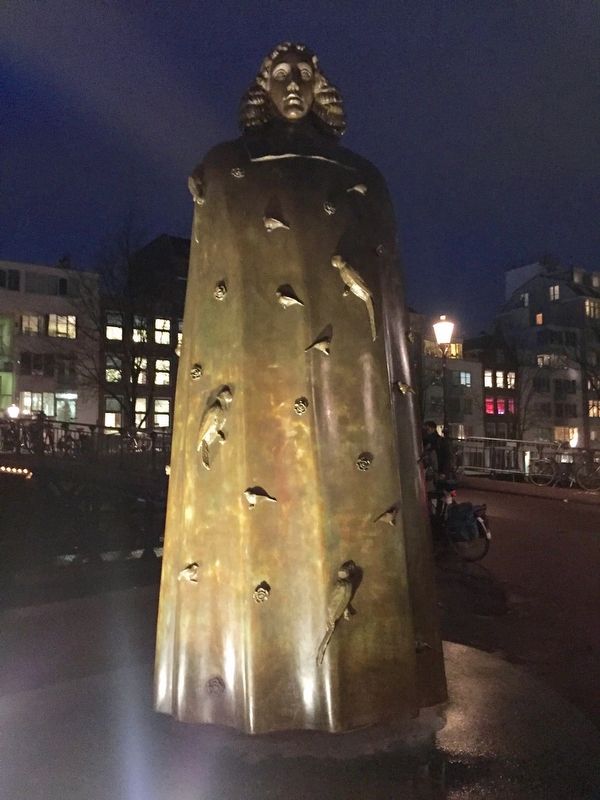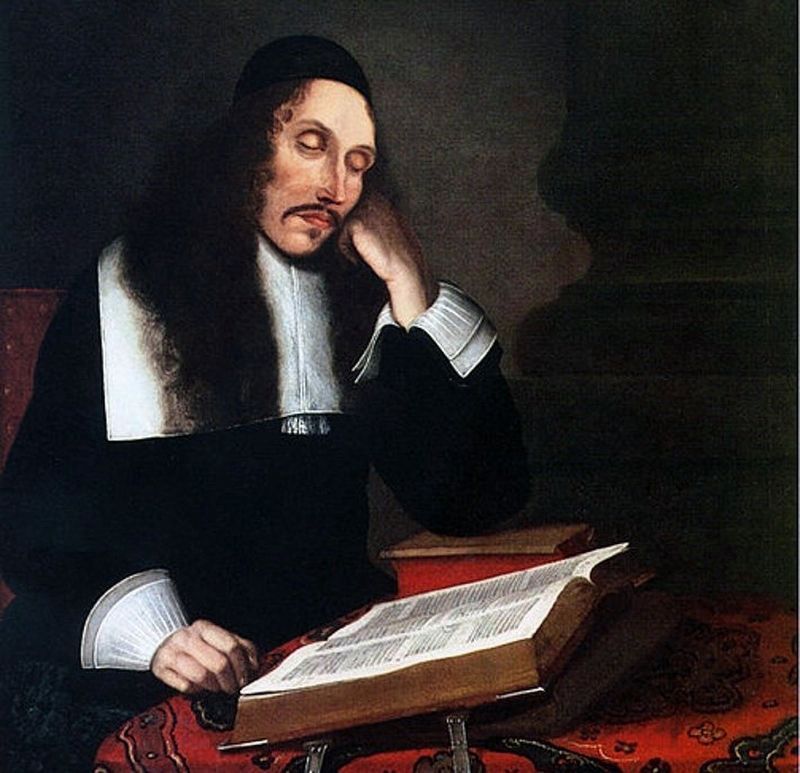Jodenbuurt in Amsterdam, North Holland, Netherlands — Northwestern Europe
Benedictus de Spinoza
(1632-1677), Amsterdammer, Filosoof/Philosopher
Inscription.
Het kunstwerk, een initiatief van de Stichting Spinoza Monument, is gerealiseerd door Nicolas Dings (1953) en bestaat uit een terrazzo podium waarop zich naast de bronzen figuur van Spinoza een icosaëder van natuursteen bevindt, die verwijst naar het slijpen van de geest. De vogels op de mantel symboliseren de multiculturele samenleving van Amsterdam, waarin de van verre komende halsbandparkiet naast de inheemse mus een plaats heeft. Het beeld is op 24 november 2008 onthuld door burgemeester Job Cohen en cultuurwethouder Carolien Gehrels en eert Spinoza als het begin van de Verlichting en voorloper van de moderne samenleving.
The artwork, an initiative of the Spinoza Monument Foundation, is by Nicolas Dings (b. 1953): It consists of a terrazzo platform upon which stands the bronze figure of Spinoza and an icosahedron of polished granite, referring to the sharpening of the mind. The birds on the cloak, in which ring-necked parakeets from faraway places intermingle with native sparrows, symbolize Amsterdam's multicultural society. The sculpture, which was unveiled on November 24th 2008 by Mayor Job Cohen and Cultural Councillor Carolien Gehrels, honours Spinoza as the beginning of the Enlightenment and precursor of modern society.
Erected 2008.
Topics. This historical marker is listed in these topic lists:
Arts, Letters, Music • Churches & Religion. A significant historical date for this entry is November 24, 2008.
Location. 52° 22.073′ N, 4° 53.952′ E. Marker is in Amsterdam, Noord-Holland (North Holland). It is in Jodenbuurt. Marker is at the intersection of Amstel and Zwanenburgwal, on the left when traveling north on Amstel. Touch for map. Marker is at or near this postal address: Zwanenburgwal 15, Amsterdam, Noord-Holland 1011 PT, Netherlands. Touch for directions.
Other nearby markers. At least 8 other markers are within walking distance of this marker. Joods Verzetsmonument /Jewish Resistance Monument (within shouting distance of this marker); Jacobus Henricus van 't Hoff (about 120 meters away, measured in a direct line); Hendrick de Keyser (about 120 meters away); Doelentoren (about 240 meters away); Elisabeth van Oostenrijk / Empress Elisabeth of Austria (about 240 meters away); Museum Willet-Holthuysen (approx. 0.3 kilometers away); Waterlooplein / Huis de Pinto (approx. 0.3 kilometers away); De Herschepping Synagogue (approx. 0.3 kilometers away). Touch for a list and map of all markers in Amsterdam.
Also see . . .
1. Baruch Spinoza (Wikipedia). Baruch Spinoza, born Benedito de Espinosa, ( 24 November 1632 – 21 February 1677, later Benedict de Spinoza) was a Dutch philosopher of Sephardi/Portuguese origin. By laying the groundwork for the 18th-century Enlightenment and modern biblical criticism, including modern conceptions of the self and the universe,he came to be considered one of the great rationalists of 17th-century philosophy. (Submitted on January 12, 2017.)
2. Baruch Spinoza (Stanford Encyclopedia of Philosophy). Bento (in Hebrew, Baruch; in Latin, Benedictus) Spinoza is one of the most important philosophers—and certainly the most radical—of the early modern period. His thought combines a commitment to a number of Cartesian metaphysical and epistemological principles with elements from ancient Stoicism, Hobbes, and medieval Jewish rationalism into a nonetheless highly original system. His extremely naturalistic views on God, the world, the human being and knowledge serve to ground a moral philosophy centered on the control of the passions leading to virtue and happiness. They also lay the foundations for a strongly democratic political thought and a deep critique of the pretensions of Scripture and sectarian religion. Of all the philosophers of the seventeenth-century, perhaps none have more relevance today than Spinoza. (Submitted on January 12, 2017.)
Credits. This page was last revised on February 3, 2023. It was originally submitted on January 12, 2017, by Andrew Ruppenstein of Lamorinda, California. This page has been viewed 566 times since then and 33 times this year. It was the Marker of the Week November 24, 2019. Photos: 1, 2, 3. submitted on January 12, 2017, by Andrew Ruppenstein of Lamorinda, California. 4. submitted on November 23, 2019, by J. J. Prats of Powell, Ohio.



